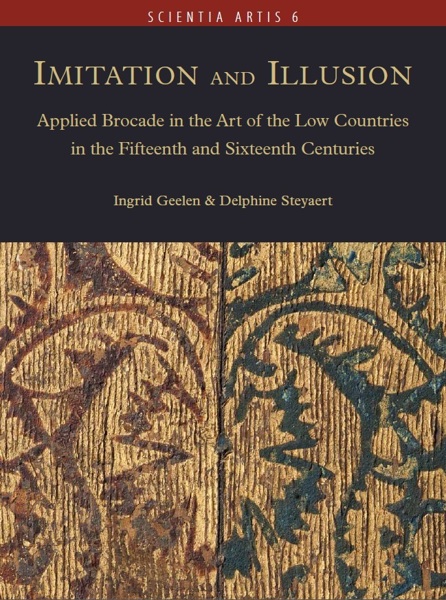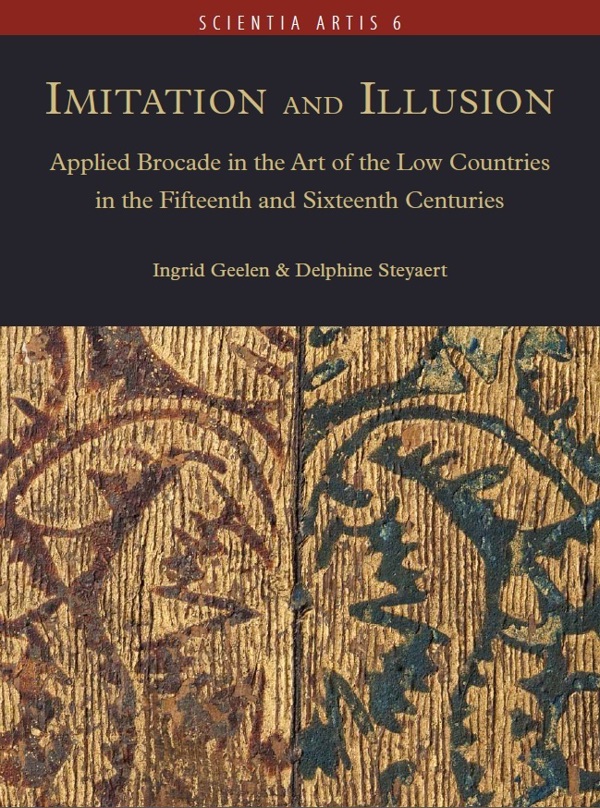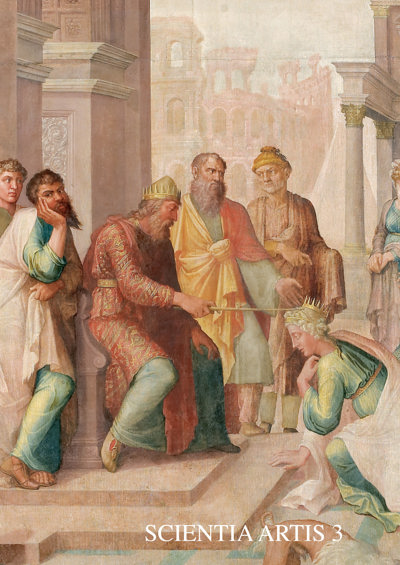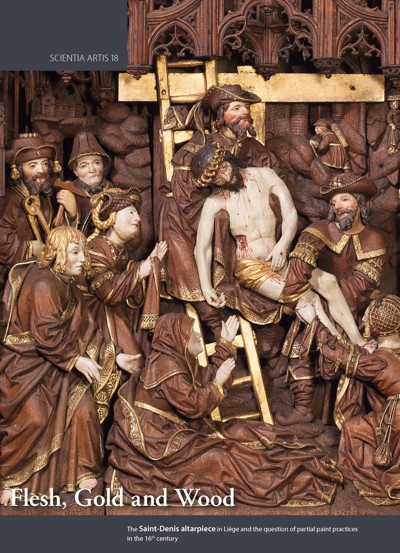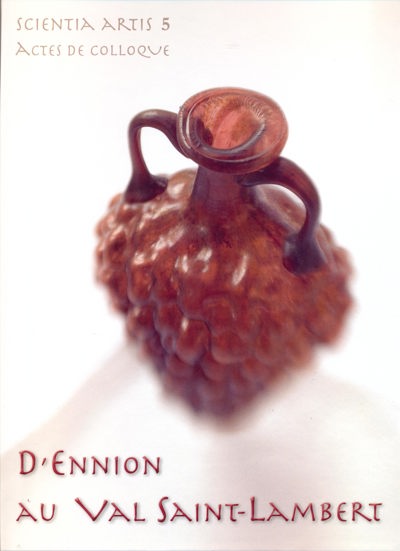
Imitation and Illusion
Applied Brocade in the Art of the Low Countries in the Fifteenth and Sixteenth Centuries
Ingrid Geelen, Delphine Steyaert
- Pages: 660 p.
- Size:230 x 290 mm
- Language(s):English
- Publication Year:2011
- € 75,48 EXCL. VAT RETAIL PRICE
- ISBN: 978-2-930054-11-7
- Hardback
- Available
"Occasionally a publication elicits envy for its scholarly scope and depth: Imitation and Illusion, beautifully illustrated, is such a book. (...) this book offers a fascinating technical study of applied brocades in Netherlandish art." (Ester van Duijn, in: HNA Review of Books, http://www.hnanews.org/hna/bookreview/current/15_Imitationandillusion1013.html)
In the late Middle Ages luxurious textiles were among the most highly prized indicators of status and wealth and an essential requirement of prestigious secular and ecclesiastical life. The depiction of these sumptuous silks and gold brocades was a crucial element in the visual arts, and their realistic and recognizable representation was a challenge to every artist. Painters and polychromers strove to imitate the fashionable fabrics by using applied brocade, a highly sophisticated form of relief decoration that adhered to panel paintings, murals and sculpture and through the play of light and shadow evoked the dazzling illusion of gold-brocaded cloths.
Imitation and Illusion is the result of a detailed study of applied brocade in the art of the Low Countries. Eleven fascinating and innovative chapters offer an in-depth examination of the historical, geographical, morphological and technical aspects of this cast tin relief technique. New light is also shed on artistic collaboration and workshop practice in the fifteenth and early sixteenth century. The catalogue includes 86 well known and lesser known panel and wall paintings, sculptures, altarpieces, and architectural elements produced between 1420 and 1540, decorated with applied brocade and providing stunning testimony to the visual variety and material magnificence of late-medieval art.
Abundantly illustrated, Imitation and Illusion investigates the artistic production of the fifteenth- and sixteenth-century Low Countries from an intriguing and original perspective. It represents a significant contribution to our understanding of medieval polychromy and will appeal to everyone whose curiosity is aroused by the illusionistic ingenuity of the medieval artist.
Foreword
Acknowledgements
Contents
Introduction
Notes to the Reader
Maps
PART ONE
Chapter One
Techniques in Luxury. A Brief History of Applied Brocade
Cast reliefs
Applied brocade
Epitaph of Canon Hendrik van Rijn with Crucifixion
Scenes from the Life of the Virgin (also known as the Kortessem Panel)
Chapter Two
Migrating Brocades. The Spread of Applied Brocade throughout Europe
In the crucible of Cologne
In Northern Germany
Up the Rhine to Swabia and Lake Constance
From Bavaria to Tyrol and the Alps
From Franconia, through Bohemia, to Lesser Poland and Transylvania
To France and Spain
To England and the Northern Netherlands
Chapter Three
Making Applied Brocade. Recipes and Methods
How to make applied brocade
Recipes
Archival references
The mould
The tin foil
The imitation of gold leaf by coloured glaze on tin foil
Pasteprints
From the Liber illuministarum or ‘Tegernsee Manuscript’
Chapter Four
Morphological Matters. The Type, Size, Relief and Design of Applied Brocade
Type: the three types of applied brocade, continuous, local and braid
Size: small, medium, large and extra-large
Relief: striations, contours and flat zones
Patterns with striations and flat zones
Patterns entirely in relief: the relief pattern
Patterns with striations, flat zones and lines in relief: the mixed pattern
Design: animals, plants, geometric and miscellaneous motifs
Animal designs
Floral and foliate designs
10 CONTENTS
Geometric designs
Miscellaneous designs
Chapter Five
Networking in Brussels. A Floral Textile Design in a Group of Carved Altarpieces with Painted Wings, 1480-1500
Around the Geel Passion Altarpiece
The Paris, Barnard Castle and Dinslaken altarpieces
Around the Stassfurt Passion Altarpiece
Chapter Six
Masters of Applied Brocade. The Geel Master of the Dianthus, Master I*T, and Other Polychromers
The Geel Master of the Dianthus
The Master of the Strängnäs I altarpiece
Master I*T and his workshop, polychromers operating in Brussels between 1500 and around 1522
Cornelis Schernier
The Strängnäs III altarpiece
The ‘Brim o de Laroussilhe’ Passion Altarpiece
Attribution by applied brocade?
The organization of carvers, polychromers and painters
Chapter Seven
The Polychromer’s Choice. The Selection and Location of Applied Brocade
on the Work of Art
Panel painting
Wall painting
Sculpture
Choosing the type of applied brocade……and deciding where to apply it on an altarpiece
Combining applied brocade with other decorative techniques
Chapter Eight
Interiors Adorned. Applied brocade in Architectural Polychromy
PART TWO
Chapter Nine
Lampas, Velvet and Cloth of Gold. Criteria for Interpreting the Representation of Textiles by Applied Brocade
Wivine Wailliez
The textiles
The representation of textiles by applied brocade: three typological criteria
Pattern
Texturing
Heights of relief
The texiles represented……and the applied brocades that represent them
Woven or embroidered motif on plain silks
Lampas represented by the Tegernsee type pattern
Gold-brocaded figured silk represented by applied brocade and Lüsterfarbenmalerei
CONTENTS 11
Cloth of gold with a linear velvet pattern represented by applied brocade with an outlined relief pattern
Alluciolato velvet represented by a combination of local applied brocade and metal cupules
Bouclé weft represented by raised dots
Bouclé weft cut pile velvet represented by applied brocade with two heights of relief, with a plain relief pattern and raised dots
A inferriata velvet represented by line gilding on glazed burnished silver leaf
Chapter Ten
A Technological Study of Applied Brocade. The Laboratory Examination of the Applied
Brocades in the Catalogue
Delphine Steyaert, Jana Sanyova, Steven Saverwyns, Ingrid Geelen and Cécile Glaude
The Filler
Visual examination of the filler
Chemical analyses of the filler
Tin foil
Glazed tin foil
Glazed tin foil covered with gold leaf on thick mordant
Glazed tin foil covered with gold leaf without a mordant
Gold leaf gilding
Highlighting
Adhesion of applied brocades
Applied brocades affixed with an adhesive
Applied brocades affixed without a specific adhesive
Finishing the already-made brocade
Appendix I. Methodology for the analysis of inorganic and organic matter
Appendix II. Constituents of fillers and adhesives
Chapter Eleven
The Contribution of X-Radiography to the Study of Applied Brocade
Elisabeth Ravaud
Production technique and X-radiographic images
Identifying the technology
Radiographic contrast of the reliefs and the type of filler
Reconstructing the design of damaged brocades
X-radiography provides further details on the condition of the brocade
PART THREE
A Word about the Catalogue
Catalogue
Bibliography
List of Works in the Catalogue
Index of Works
Index of Names
Picture Acknowledgements
